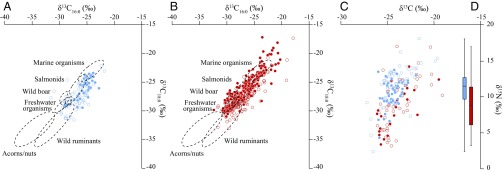Fig. 3.
Bulk and single-compound stable isotope data from the Late Pleistocene/Incipient Jōmon (blue) and Early Holocene/Initial Jōmon (red) ceramic vessels. δ13C values of C16:0 and C18:0 n-alkanoic acids extracted from Late Pleistocene/Incipient (A) and Early Holocene/Initial (B) Jōmon pottery, which show a broadening of aquatic resources. The 95% confidence ellipses are based on modern Japanese authentic reference fats (5, 6, 21–23). Bulk δ13C and δ15N stable isotope data (C) obtained from carbonized residues adhering to Incipient and Initial Jōmon vessels (some data previously reported in refs. 5, 6, 40, and 41). (D) Box plot of the δ15N values, which also demonstrate a broadening of aquatic resources. Filled circle, sample with aquatic biomarkers and/or phytanic acid SRR ratio >75.5%; open circle, absence of aquatic biomarkers and/or phytanic acid SRR ratio <75.5%.

